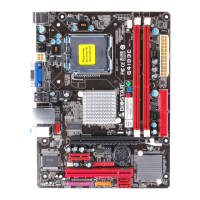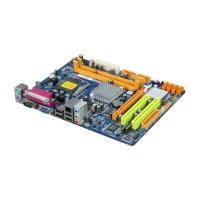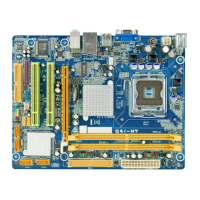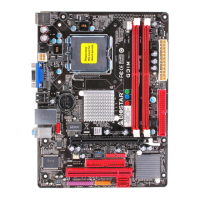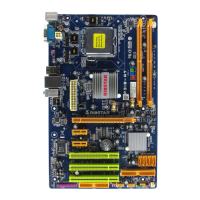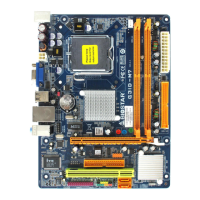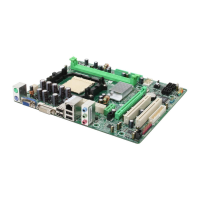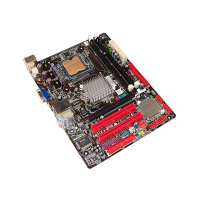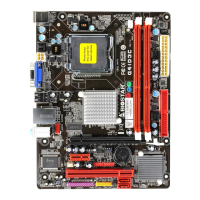

Do you have a question about the Biostar G41D3C and is the answer not in the manual?
| Form Factor | Micro ATX |
|---|---|
| Chipset | Intel G41 |
| Socket | LGA 775 |
| Memory Type | DDR3 |
| Memory Slots | 2 |
| Maximum Memory | 8 GB |
| Integrated Graphics | Intel GMA X4500 |
| Storage Interface | 4 x SATA 3Gb/s |
| Video Outputs | 1 x VGA |
| Audio | Realtek ALC662 6-Channel HD Audio |
| IDE Ports | 1 x IDE |
| USB Ports | 8 x USB 2.0 |
| LAN | Realtek RTL8111E |
| Expansion Slots | 1 x PCIe x16, 1 x PCIe x1, 2 x PCI |
Describes the AMI BIOS Setup program, its purpose, and basic system control.
Confirms AMI BIOS support for the Plug and Play Version 1.0A specification.
States AMI BIOS support for the EPA Green PC specification version 1.03.
Details AMI BIOS support for Advanced Power Management (APM) specification versions 1.1 & 1.2.
Explains AMI ACPI BIOS support for version 1.0/2.0, providing ASL code for power management.
Confirms AMI BIOS support for Intel PCI local bus specification version 2.3.
States support for DDR3 SDRAM (Double Data Rate III Synchronous DRAM).
Indicates that the AMI BIOS supports Intel CPUs.
Explains how to enter the BIOS setup utility using the DEL key and navigate with keys.
Shows system information including BIOS version, built date, etc.
Shows system memory size, VGA shard memory will be excluded.
Set the system internal clock.
Set the system date. Note that the 'Day' automatically changes when you set the date.
Controls the onboard IDE controller, with options for Enhanced, Compatible, or Disabled.
Sets the SATA channel configuration sequence, with options like Before PATA or Behind PATA.
Appears when ATA/IDE is Compatible; allows selection of SATA/PATA channels.
Sets device type, LBA/Large Mode, PIO/DMA Mode, S.M.A.R.T, and 32-bit transfer.
Disables or enables device write protection, effective when accessed through BIOS.
Selects the time out value for detecting IDE/SATA devices.
Allows configuration of advanced CPU settings like C1E, Prefetcher, and Virtualization Tech.
Configures Super IO chipset settings, including parallel port and power-on options.
Monitors system temperature, fan speed, and voltage information.
Controls CPU and System fan speed based on temperature using smart fan features.
Manages ACPI settings, including version features, APIC support, and resume events.
Configures USB controller modes, legacy support, and mass storage device settings.
Enables/disables Enhanced Halt State for power saving and heat reduction.
Enables/disables hardware prefetcher for improved memory read latency.
Enables/disables adjacent cache line prefetch for reduced cache latency.
Sets the maximum CPUID input value the OS can query.
Enables/disables virtualization for separating system resources.
Enables/disables Execute Disabled Bit for protection against buffer overflow attacks.
Sets parallel port address and function mode (Normal, EPP, ECP).
Selects the DMA channel for parallel port ECP mode.
Selects the IRQ for the onboard parallel port.
Controls the keyboard power on function, including specific key or stroke key options.
Controls the mouse power on function.
Specifies system behavior after power failure (Power Off, Power ON, Last State).
Enables/disables the display of PC health status during POST.
Sets the CPU shutdown temperature, effective under Windows 98 ACPI mode.
Allows enabling/disabling the CPU Smart Fan function.
Auto tests and detects CPU/System fan functions and speeds.
Provides operation modes for the fan: Quiet, Performance, or Manual.
Sets Fan Ctrl OFF and Fan Ctrl On temperature thresholds (°C).
Sets the temperature value for CPU/System fan to start under Smart Fan Function mode.
Adjusts the speed of CPU/System fan by increasing the value.
Allows selection of the ACPI version (v1.0, v2.0, v3.0).
Enables/disables the motherboard's APIC for multiprocessor support and IRQ handling.
Allows ACPI BIOS to add a pointer to an OEMB table in the Root System Description Table.
Enables/disables headless server operation, which runs without keyboard, monitor, or mouse.
Allows control of the energy lake feature.
Enables/disables the APIC ACPI SCI IRQ.
Enables/disables the HPET for high-performance timing.
Sets the memory address for the HPET.
Sets the date and time for the RTC alarm to awaken the system from Suspend mode.
Allows selection of the system boot-up date and time.
Shows USB controller and device information, including legacy support and modes.
Selects the operation mode of the USB 2.0 controller (HiSpeed, FullSpeed).
Enables/disables support for operating systems without an EHCI hand-off feature.
Configures USB mass storage device reset delay and emulation type.
Allows clearing the NVRAM (CMOS) data by selecting 'Yes'.
Determines if the OS or BIOS initializes PnP cards for the boot sequence.
Controls how long a PCI device holds the PCI bus before another takes over.
Allows BIOS to choose an IRQ to assign for the PCI VGA card.
Enables/disables palette snooping for graphic controllers needing VGA compatibility.
Toggles the built-in driver for onboard IDE controller DMA transfers.
Assigns system interrupt types to devices, with 'Available' for automatic assignment.
Assigns DMA channels to devices, with 'Available' for automatic assignment.
Reserves memory size for specific PCI devices.
Specifies the boot device priority sequence from available devices.
Arranges or allows changing the hard disk boot sequence.
Arranges or allows changing the removable drive boot sequence.
Arranges or allows changing the CD/DVD drive boot sequence.
Enables an abridged version of POST to speed up booting.
Enables/disables the Full Screen LOGO Show function.
Sets the display mode for option ROM.
Selects the NumLock state after the system is switched on.
Allows option ROMs to trap interrupt 19 for boot disk function.
Enables/disables a beep to notify the user of boot success.
Configures specific chipset features, bus speeds, and memory resources.
Configures North Bridge features, including memory remapping and graphics adapter.
Configures South Bridge features, including USB, Audio, and LAN controls.
Enables/disables remapping of overlapped PCI memory above total physical memory.
Enables/disables the VGA controller.
Selects the internal graphics mode and fixed frame buffer size.
Configures GMCH Protected Audio Video Path (PAVP) support.
Toggles the enabling or disabling of the PCI Express port.
Configures DVMT Mode Select and DVMT/FIXED Memory Size.
Selects the DVMT mode (DVMT Mode or Fixed Mode).
Sets the amount of memory allocated for Dynamic Video Memory Technology.
Determines the number of functional USB ports (8, 6, 4, 2, or Disabled).
Enables/disables the EHCI controller for high-speed USB support.
Allows selection of the Audio support (Azalia or All Disabled).
Enables or disables the Onboard LAN functionality.
Selects the Onboard LAN Boot ROM option.
Shows the LAN MAC ID.
Enables/disables the SMBus controller.
Sets the assertion width for SLP_S4# signal.
Enables SpeedStep technology for dynamic CPU clock speed adjustment and power saving.
Sets the CPU ratio frequency and the CPU frequency.
Allows selection of PCIE clock control (Auto or Manual).
Controls the Memory Clock, with options for DDR3 800MHz or 1066MHz.
Enables/disables DRAM timing configuration by SPD.
Sets the CAS Latency (tCL) for DRAM timing.
Sets the Row Active Time (tRAS) for DRAM timing.
Sets the Row Precharge Time (tRP) for DRAM timing.
Sets the Row Column Delay (tRCD) for DRAM timing.
Sets the Write Recovery Time (tWR) for DRAM timing.
Sets the Refresh Cycle Time (tRFC) for DRAM timing.
Sets the Write to Read Delay (tWTR) for DRAM timing.
Sets the Row to Row Delay (tRRD) for DRAM timing.
Sets the Read to Precharge Delay (tRTP) for DRAM timing.
Saves all configuration changes to CMOS RAM and exits the setup utility.
Abandons all changes made during the current session and exits the setup utility.
Abandons all changes and restores previously saved values.
Reloads BIOS with factory settings optimized for the system.
Sets a supervisor password to restrict access to setup utility changes.
Allows the supervisor to set the user access level (Full, No Access, View Only, Limited).
Sets or modifies the user password for BIOS access.
Clears the user password from the BIOS settings.
Sets the timing for checking passwords (Setup or Always).
Enables/disables virus warning for the IDE Hard Disk boot sector.
